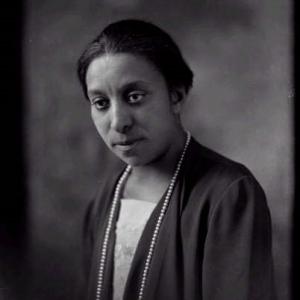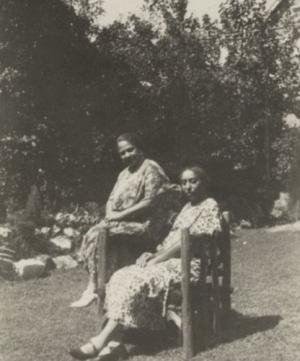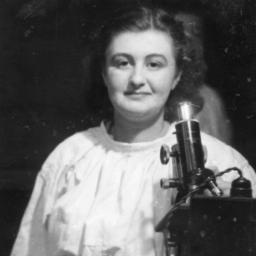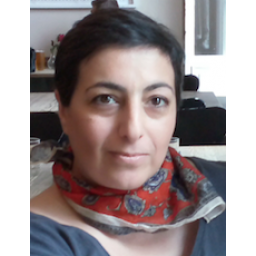Lucy Diggs Slowe

Slowe was born in 1883 in Berryville, Virginia and was orphaned by the age of 6. She was taken in by her aunt who prioritized quality education.
She later earned both a bachelor’s and master’s degree in English and became first to be Howard University’s Dean of Women.
Slowe made a great impact on female students at the university, paving the way not only for them but Black women administrators as well
“Education must fit…[African-American] women, as it must fit all women, for the highest development of their own gifts; but, whatever those gifts, they will not be able to exercise them unless they understand the world they live in and are prepared to make their contribution to it,” Lucy Diggs Slowe, “Higher Education of Negro Women,” 1933
Early Life
On July 4, 1883, Lucy Diggs Slowe was the 7th child born to parents Henry and Fannie Slowe. The family lived in Berryville, Clarke County, Virginia. Slowe did not have the chance to get to know her parents, as her father died before she was one. At the age of six, she was orphaned due to the loss of her mother. Martha Slowe Price, her aunt and sister to Henry Slowe, raised Slowe and her six siblings in Lexington, Virginia. It was not long before Price moved the family to Baltimore, Maryland in search of better educational opportunities (Steedman).
In 1896, at 13 years old, Slowe was a student in the segregated Baltimore school system. Eight years later in 1904, she graduated from the Baltimore Colored School at the age of 21 (Maryland Women’s Hall of Fame 2011, Verongos 2020). A few years older than most of her peers, Slowe faced difficulties with learning in her earlier years. After a bout of homeschooling, it was then that she re-entered the public school system (Verongos 2020). Though there was a gap in age, Slowe began to excel academically – so much so that she was the first female alum and scholarship recipient of the Baltimore Colored School to attend Howard University (Maryland Women’s Hall of Fame 2011).
Her involvement in extracurricular activities as a college student was extensive, ranging from pursuits as a tennis player (subsequently becoming President of the Women's Tennis Club) to serving as Vice President and Secretary of the Alpha Phi Literary Society (Steedman). Slowe was also a co-founder of Alpha Kappa Alpha Sorority, Inc. (AKA) – the first sorority developed by and for African women that still exists today, remaining a “center of mutual support, activism, and service for generations to come,” (Maryland Women’s Heritage Center). Slowe served as the sorority’s very first President (Steedman).
Slowe graduated from Howard University in 1908. She received her bachelor’s degree in English and graduated at the top of her class as valedictorian. It was not long after graduation before Slowe’s professional career began to flourish. Promptly following graduation, she was offered a teaching position at Douglass High School in Baltimore. It was during this time that Slowe met eventual life partner and fellow educator, Mary Burrill.
Three years later, Slowe pursued further education at Columbia University’s Graduate School of Arts and Science in New York. In 1915, she earned her master’s degree in English. In tandem with her graduate studies, Slowe had also been engaged in the field of School Administrative Studies at the Teacher’s College at Columbia University (Steedman). These efforts landed her an opportunity to teach in Washington, DC at Armstrong Manual High, where Burrill worked as well. During this time, the couple moved in together. They were not overt about their partnership, but their closest confidants were aware of the romantic nature of their relationship.
All while making large professional and personal strides, Slowe remained an active tennis player. In 1917, she won the first women’s title at the American Tennis Association’s (ATA). This made her the first African American to win a national title in any sport (Maryland Women’s Hall of Fame 2011). Throughout her time as a tennis player, Slowe was a 17-time tennis champion (American Tennis Association.).
Professional Pursuits
In 1919, the first Black junior high school opened in DC and Slowe was hired as principal. During her time as principal, she “organized the school, developed curriculums, designed and planned an in-service training system for teachers, and educed Columbia University to offer an extension course in education attended by black teachers and white junior high staff,” (Maryland Commission for Women 2011). After many years as an educator, Slowe found herself presented with a life-changing job offer. In 1922, she became not only an English professor at Howard, but the university’s first Dean of Women as well. She made history, as Slowe was Howard’s first person to hold the latter position (Steedman). This new role also enabled Slowe and Burrill to buy a home together in DC’s Brookland neighborhood (Queerplaces).

Time in undergrad spent both studying and conducting administrative work proved to be beneficial in Slowe’s new professional endeavors. She also made a point of examining the careers of other female deans at different universities. This study gave her ideas as to how to confront issues specific to Howard. One of her most impactful decisions as Dean of Women included creating three new women-only dorms on campus in 1931. She emphasized that these dorms were necessary for “...women students for their physical and social development as well as for the training of their minds,” (Lentz). Additionally, she also provided freshmen with mentors to aid them in navigating university and ensured the inclusion of female students in campus policymaking (Maryland Commission for Women 2011, Steedman).
Slowe also developed the Women Student's League, which was meant to “help all of the female students at Howard University become more active in campus…leadership roles,” (Steedman). Slowe’s efforts and the desires of students did not always gel. Some students sought out “urban recreation” and “social autonomy,” (Maryland Women’s Heritage Center). Though not a fan of women being confined to societal norms, Slowe still held beliefs that female students would be wise to adhere to “more conventional [ideas] of womanhood,” (Maryland Women’s Heritage Center). This created ideological conflict between Slowe and her students, though students still recognized the benefits of her groundbreaking work as Dean of Women.
At the core of her pursuits, Slowe aimed to empower young women and provide them with the tools to succeed. She felt that college was the ideal avenue for women to gain their independence. The same year she became Dean of Women, Slowe was also elected President of the National Association of College Women (NACW). This allowed her to realize her goals of eradicating gender-based discrimination on a scale far beyond Howard University. In fact, her work as Dean of Women and president of the NACW was so impactful that other historically black colleges modeled many of their practices after Slowe (Maryland Commission for Women 2011).
While working as a leader at Howard and the NACW, Slowe was also a part of numerous other organizations. Slowe served not only as the co-founder of the Association of Deans of Women and Advisers to Girls in Negro Schools, but also as part of the leadership of the National Council of Negro Women as well. Additionally, she was a member of the following: The American Association of University Women, The National Association for Women Deans, The Young Women's Christian Association and The Women's International League for Peace and Freedom. Slowe made an impact wherever she went - forever changing the landscape for African American female students and administrators alike. However, her professional journey was not without its challenges.
Rising Tensions: Combating Gender-Based Discrimination on Campus
In the later years of Slowe’s time as dean, she began to face challenges from the university administration. Slowe had a harmonious relationship with the president of Howard University, J. Stanley Durkee. It was after his departure, and the election of Howard University President Mordecai Johnson, that issues arose. Johnson was greatly appalled by her “liberal attitude of women,” and Slowe was certainly not shy about her beliefs (Steedman). Though hear ideals manifested most often through her actions, she was also unabashed in her words. She once wrote in The Journal of Negro Education,
"Negro women...must be prepared for the responsibilities of citizenship if they are to discharge their duties to the government under which they live, and if they are to be capable of watching their own interests, and of using their ballot in preserving and promoting these interests,” (Steedman).
Slowe and Johnson not only had conflicting beliefs but did not see eye to eye on what actions to take regarding student matters. In an incident where a student reported sexual harassment by a professor, Slowe determined it was only right to fire the professor. Johnson resisted. Other conflicts included “refusing her budget requests, removing her from the Board of Deans, and allowing her pay relative to other deans to decline,” (Maryland Women’s Heritage Center). He aimed to counter her efforts and diminish her power.
Johnson also began to infringe on her personal life. Where previous university President J. Stanley Durkee granted Slowe the ability to live off campus just as male deans could, Johnson sought to revoke those privileges. Slowe did not take his harassment lightly - she alerted the press, colleagues and community members, as well as Howard alumni. This soured their relationship even further. As such, Johnson escalated the conflict, ultimately encouraging Slowe to no longer serve as dean and, instead, go back to teaching full-time (Verongos 2020). She did not yield and continued to struggle with Johnson until she physically couldn’t any longer.
The stress brought on by the endless quarrels left Slowe bedridden. Her ailments did not stop Johnson’s harassment, though. It is said that in September of 1937, he “...ordered a subordinate to go to her sickbed and deliver an ultimatum: Either return to campus within 24 hours or be replaced as dean,” (Verongos 2020). Slowe died a month later.
Later Life and Legacy
On October 21st, 1937, Slowe passed away at age of 52 from kidney failure. The following year, a memorial was held to honor her legacy. This memorial was well attended, with many other women in the fight for women’s education paying their respects (Lentz). The loss of Slowe was felt deeply not only in the community and amongst close friends and family, but in the home she shared with her partner. Mary Burrill was said to have “...kept Slowe’s picture on her piano, next to a vase filled with white carnations” (Queerplaces). They were a couple for 25 years.
Slowe has been recognized in a variety of ways. Her life and legacy were featured in the National Association of Women Deans, Administrators and Counselors 70th anniversary convention in 1986 (Lentz). The organization also has a plaque in their headquarters in DC that honors Slowe. Howard University, where Slowe made an immeasurable impact, named one of their halls Lucy D. Slowe Hall. On October 22, 2021, Howard University also named a street, 2400 block of 4th Street NW, after her - Lucy Diggs Slowe Way. Lucy Diggs Slowe Elementary School, once located in DC, also donned her name. The school had a historic legacy, opening in 1945 to provide education for Black students in the Brookland neighborhood (DC Historic Sites). Though not planned to be named after Slowe when the school was first built, a renaming was eventually approved (DC Historic Sites). Lucy Diggs Slowe Elementary remained open until 2009.

Slowe’s journey to becoming an educator presented challenges from the very beginning. However, her unwavering determination and desire to learn propelled her into a fruitful and life-altering career. Her time as a student and, later as an educator, informed her work as an administrator. She made a lasting impact on the students she served and inspired colleagues far and wide through her tenacious spirit and drive – as reflected by the many organizations she both founded and was a member of. Slowe’s legacy is truly undeniable, spanning far and wide - felt by all who follow in her footsteps.
 Primary Source Analysis Strategies
Primary Source Analysis Strategies
Slowe and Burrill (Photograph)
Caption: Slowe (right) and Burrill (left) sit in the backyard of their home located in D.C.’s Brookland neighborhood. Burrill appears to be smiling as she looks at the camera.
Primary Source Analysis Questions:
-
What do you notice first about this image?
-
What do you wonder about the significance of homeownership for two African American women at this time?
-
Who do you think took this photo? What elements about this photo draw you to that conclusion?
Lucy Diggs Slowe Hall (Photograph)
Caption: This is a 1949 image of Lucy Diggs Hall located on Howard University’s campus.
Primary Source Analysis Questions:
-
What do you believe is the significance of naming buildings after historical figures?
-
Based on what you have learned in this resource, why do you think that this hall was named after Slowe?
Educator Notes
This resource outlines different lenses that students can examine through primary resources. There is no specific order to use the columns in. The questions students develop through their examination are meant to encourage further research and curiosity. Educators can then propose other activities (as outlined in the resource) that help students further contextualize different - but related - primary sources.
This is a blank version of the previous link. Educators can create their own specific sample questions (most likely based on the medium of the primary source to have students answer in each column), or simply have students fill out this document with the guidance of the original document.
Lentz, Eddy. “Lucy Diggs Slowe.” Ivy League Black History. n.d. http://ivy50.com/blackhistory/story.aspx?sid=12%2F28%2F2006.
“Lucy Diggs Slowe.” American Tennis Association. n.d. https://www.yourata.org/historic-pioneers/lucy-diggs-slowe.
“Lucy Diggs Slowe.” Biographies - Lucy Diggs Slowe. 2011. https://msa.maryland.gov/msa/educ/exhibits/womenshallfame/html/slowe.html.
“Lucy Diggs Slowe Elementary School,” DC Historic Sites. n.d. https://historicsites.dcpreservation.org/items/show/1123.
“Lucy Diggs Slowe (1885 - 1937).” Maryland Women’s Heritage Center. n.d. https://mdwomensheritagecenter.org/directory-suffragebios/listing/lucy-slowe-diggs/.
Steedman, Emily. “Lucy Diggs Slowe (1883-1937).” Archives of Maryland (Biographical Series). n.d. https://msa.maryland.gov/megafile/msa/speccol/sc3500/sc3520/015500/015532/html/15532bio.html#1.
Verongos, Helen T. “Overlooked No More: Lucy Diggs Slowe, Scholar Who Persisted against Racism and Sexism.” The New York Times, October 1, 2020. https://www.nytimes.com/2020/10/01/obituaries/lucy-diggs-slowe-overlooked.html.
Queerplaces - Mary P. Burrill. n.d. http://www.elisarolle.com/queerplaces/klmno/Mary%20P.%20Burrill.html.
Main Image Citation: “Lucy Slowe.” Alpha Kappa Alpha, CC BY-SA 3.0 <http://creativecommons.org/licenses/by-sa/3.0/>, via Wikimedia Commons.
MLA – Dawson, Shay. "Lucy Diggs Slowe." National Women's History Museum. National Women's History Museum, 2024. Date accessed.
Chicago - Dawson, Shay. “Lucy Diggs Slowe." National Women's History Museum. 2024.
Anderson, Karen, “Brickbats and Roses: Lucy Diggs Slowe, 1883-1937.” In Lone Voyagers: Academic Women in Coeducational Institutions, 1870-1937, 283-307. Edited by Geraldine Joncich Clifford (New York: The Feminist Press, 1989).
Miller Carroll L. L. and Anne S. Pruitt-Logan, Faithful to the Task at Hand: The Life of Lucy Diggs Slowe (Albany, NY: SUNY Press, 2012)
Rasheed, Lisa R., “Lucy Diggs Slowe, Howard University Dean of Women, 1922-1937: Educator, Administrator, Activist” (Ph.D. Dissertation, Georgia State University, 2009). http://scholarworks.gsu.edu/eps_diss/55.
For further information or questions, please contact history@womenshistory.org.




